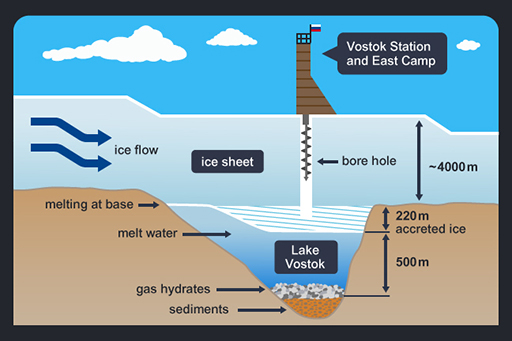2.6 Is Lake Vostok like Europa?
The discovery of tidal heating and a potential global ocean on Europa is of great interest to astrobiologists, as the one requirement for all life (as we know it) is liquid water. Life is incredibly diverse on Earth and astrobiologists study the types of microbe (bacteria and similar organisms) that can survive in extreme environments, to better understand life’s limits. So what does an astrobiologist do, and what makes Europa a potentially habitable moon?
Europa has three times the amount of water found on Earth. We can deduce from Europa’s overall density that there is about a 100-km deep layer of H2O overlying its rocky interior, but this doesn’t distinguish between liquid (water) and solid (ice) because their densities are too similar. We can see that the outer part is frozen. Interpretation of the surface features has led most scientists to conclude that there is probably a liquid water zone beneath the frozen exterior, possibly in the form of a global ocean between the ice and the rocky interior. Episodes of tidal heating could heat the rock (or even cause submarine volcanic eruptions), warming the ocean to the extent that regions of the overlying ice melted, producing the rafts-and-matrix chaos areas that you have seen. In addition, tidal stressing of the ice shell could cause a few cracks to open and close during the tidal cycle, twice for every orbit around Jupiter.
All life as we know it needs liquid water to survive. As well as water, microbes need an active environment, where minerals and elements are cycled and concentrated.
Compare Europa with Lake Vostok in Antarctica, a lake that is buried beneath 3.2 km of ice and has been so for between 14 million and 34 million years. Scientists drilled through this ice and reached Lake Vostok in 2013. They claim to have found previously unidentified species of bacteria. Although some are questioning this claim as potential contamination, if life is found to exist in Lake Vostok then studying these organisms will improve our understanding of how microbes can survive in such isolated, cold, dark conditions.

